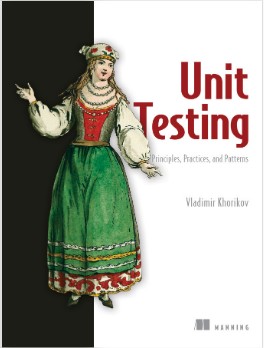
Autor: Vladimir Khorikov
Broj strana: 304
ISBN broj: 9781617296277
Izdavač:
MANNING PUBLICATIONS ![]()
Godina izdanja: 2020.
 |
 |
 |
 |
 |
||||
This book is an indispensable resource. Greg Wright, Kainos Software Ltd. Unit Testing Principles, Patterns and Practices shows you how to refine your existing unit tests by implementing modern best practices. You’ll learn to spot which tests are performing, which need refactoring, and which need to be deleted entirely! Upgrade your testing suite with new testing styles, good patterns, and reliable automated testing. Part 1: The bigger picture
1.1 The current state of unit testing
1.2 The goal of unit testing
1.2.1 What makes a good or bad test?
1.3 Using coverage metrics to measure test suite quality
1.3.1 Understanding the code-coverage metric
1.3.2 Understanding the branch coverage metric
1.3.3 Problems with coverage metrics
1.3.4 Aiming at a particular coverage number
1.4 What makes a successful test suite?
1.4.1 It’s integrated into the development cycle
1.4.2 It targets only the most important parts of your code base
1.4.3 It provides maximum value with minimum maintenance costs
1.5 What you will learn in this book
1.6 Summary
2.1 The definition of "unit test"
2.1.1 The isolation issue: The London take
2.1.2 The isolation issue: The classical take
2.2 The classical and London schools of unit testing
2.2.1 How the classical and London schools handle dependencies
2.3 Contrasting the classical and London schools of unit testing
2.3.1 Unit testing one class at a time
2.3.2 Unit testing a large graph of interconnected classes
2.3.3 Revealing the precise bug location
2.3.4 Other differences between the classical and London schools
2.5 Integration tests in the two schools
2.5.1 End-to-end tests are a subset of integration tests
2.6 Summary
3.1 How to structure a unit test
3.1.1 Using the AAA pattern
3.1.2 Avoid multiple arrange, act, and assert sections
3.1.3 Avoid if statements in tests
3.1.4 How large should each section be?
3.1.5 Differentiating the system under test
3.1.6 Dropping the arrange, act, and assert comments from tests
3.2 Exploring the xUnit testing framework
3.3 Reusing test fixtures between tests
3.3.1 High coupling between tests is an anti-pattern
3.3.2 The use of constructors in tests diminishes test readability
3.3.3 A better way to reuse test fixtures
3.4 Naming a unit test
3.4.1 Unit test naming guidelines
3.4.2 Example: Renaming a test toward the guidelines
3.5 Refactoring to parameterized tests
3.5.1 Generating data for parameterized tests
3.6 Using an assertion library to further improve test readability
3.7 Summary
Part 2: Making your tests work for you
4.1 Diving into the four pillars of a good unit test
4.1.1 The first pillar: Protection against regressions
4.1.2 The second pillar: Resistance to refactoring
4.1.3 What causes false positives?
4.1.4 Aim at the end result instead of implementation details
4.2 The intrinsic connection between the first two attributes
4.2.1 Maximizing test accuracy
4.2.2 The importance of false positives and false negatives: The dynamics
4.3 The third and fourth pillars: Fast feedback and maintainability
4.4 In search of an ideal test
4.4.1 Is it possible to create an ideal test?
4.4.2 Extreme case #1: End-to-end tests
4.4.3 Extreme case #2: Trivial tests
4.4.4 Extreme case #3: Brittle tests
4.4.5 In search of an ideal test: The results
4.5 Exploring well-known test automation concepts
4.5.1 Breaking down the Test Pyramid
4.5.2 Choosing between black-box and white-box testing
4.6 Summary
5.1 Differentiating mocks from stubs
5.1.1 The types of test doubles
5.1.2 Mock (the tool) vs. mock (the test double)
5.1.3 Don’t assert interactions with stubs
5.1.4 Using mocks and stubs together
5.1.5 How mocks and stubs relate to commands and queries
5.2 Observable behavior vs. implementation details
5.2.1 Observable behavior is not the same as a public API
5.2.2 Leaking implementation details: An example with an operation
5.2.3 Well-designed API and encapsulation
5.2.4 Leaking implementation details: An example with state
5.3 The relationship between mocks and test fragility
5.3.1 Defining hexagonal architecture
5.3.2 Intra-system vs. inter-system communications
5.3.3 Intra-system vs. inter-system communications: An example
5.4 The classical vs. London schools of unit testing, revisited
5.4.1 Not all out-of-process dependencies should be mocked out
5.4.2 Using mocks to verify behavior
5.5 Summary
6.1 The three styles of unit testing
6.1.1 Defining the output-based style
6.1.2 Defining the state-based style
6.1.3 Defining the communication-based style
6.2 Comparing the three styles of unit testing
6.2.1 Comparing the styles using the metrics of protection against regressions and feedback speed
6.2.2 Comparing the styles using the metric of resistance to refactoring
6.2.3 Comparing the styles using the metric of maintainability
6.2.4 Comparing the styles: the results
6.3 Understanding functional architecture
6.3.1 What is functional programming?
6.3.2 What is functional architecture?
6.3.3 Comparing functional and hexagonal architectures
6.4 Transitioning to functional architecture and output-based testing
6.4.1 Introducing an audit system
6.4.2 Using mocks to decouple tests from the filesystem
6.4.3 Refactoring toward functional architecture
6.4.4 Looking forward to further developments
6.5 Understanding the drawbacks of functional architecture
6.5.1 Applicability of functional architecture
6.5.2 Performance drawbacks
6.5.3 Increase in the code base size
6.6 Summary
7.1 Identifying the code to refactor
7.1.1 The four types of code
7.1.2 Using the Humble Object pattern to split overcomplicated code
7.2 Refactoring toward valuable unit tests
7.2.1 Introducing a customer management system
7.2.2 Take 1: Making implicit dependencies explicit
7.2.3 Take 2: Introducing an application services layer
7.2.4 Take 3: Removing complexity from the application service
7.2.5 Take 3: Introducing a new Company class
7.3 Analysis of optimal unit test coverage
7.3.1 Testing the domain layer and utility code
7.3.2 Testing the code from the other three quadrants
7.3.3 Should you test preconditions?
7.4 Handling conditional logic in controllers
7.4.1 Using the CanExecute/Execute pattern
7.4.2 Using domain events to track changes in the domain model
7.4.3 Conclusion
7.5 Summary
Part 3: Integration testing
8.1 What is an integration test?
8.1.1 The role of integration tests
8.1.2 The test pyramid revisited
8.1.3 Integration testing versus failing fast
8.2 Which out-of-process dependencies to test directly
8.2.1 The two types of out-of-process dependencies
8.2.2 Working with both managed and unmanaged dependencies
8.2.3 What if you can’t use a real database in integration tests?
8.3 Integration testing: An example
8.3.1 What scenarios to test?
8.3.2 Categorizing the database and the message bus
8.3.3 What about end-to-end testing?
8.3.4 Integration testing: The first try
8.4 Using interfaces to abstract dependencies
8.4.1 Interfaces and loose coupling
8.4.2 Why use interfaces for out-of-process dependencies?
8.4.3 Using interfaces for in-process dependencies
8.5 Integration testing best practices
8.5.1 Making domain model boundaries explicit
8.5.2 Reducing the number of layers
8.5.3 Eliminating circular dependencies
8.5.4 Using multiple act sections in a test
8.6 How to test logging functionality?
8.6.1 Should you test logging?
8.6.2 How to test logging?
8.6.3 How much logging is enough?
8.6.4 How to pass logger instances around?
8.6.5 Conclusion
8.7 Summary
9.1 Maximizing mocks' value
9.1.1 Verifying interactions at the system edges
9.1.2 Replacing mocks with spies
9.1.3 What about IDomainLogger?
9.2 Mocking best practices
9.2.1 Mocks are for integration tests only
9.2.2 Not just one mock per test
9.2.3 Verifying the number of calls
9.2.4 Only mock types that you own
9.3 Summary
10.1 Prerequisites for testing the database
10.1.1 Keeping the database in the source control system
10.1.2 Reference data is part of the database schema
10.1.3 Separate instance for every developer
10.1.4 State-based versus migration-based database delivery
10.2 Database transaction management
10.2.1 Managing database transactions in production code
10.2.2 Managing database transactions in integration tests
10.3 Test data life cycle
10.3.1 Parallel versus sequential test execution
10.3.2 Clearing data between test runs
10.3.3 Avoid in-memory databases
10.4 Reusing code in test sections
10.4.1 Reusing code in arrange sections
10.4.2 Reusing code in act sections
10.4.3 Reusing code in assert sections
10.4.4 Does the test create too many database transactions?
10.5 Common database testing questions
10.5.1 Should you test reads?
10.5.2 Should you test repositories?
10.5.3 Conclusion
10.6 Summary
Part 4: Unit testing best practices
11.1 Unit testing private methods
11.1.1 Private methods and test fragility
11.1.2 Private methods and insufficient coverage
11.1.3 When testing private methods is acceptable
11.2 Exposing private state
11.3 Leaking domain knowledge to tests
11.4 Code pollution
11.5 Mocking concrete classes
11.6 Working with time
11.6.1 Time as an ambient context
11.6.2 Time as an explicit dependency
11.6.3 Conclusion
11.7 Summary
Great testing practices will help maximize your project quality and delivery speed. Wrong tests will break your code, multiply bugs, and increase time and costs. You owe it to yourself—and your projects—to learn how to do excellent unit testing to increase your productivity and the end-to-end quality of your software.
Unit Testing Principles, Patterns and Practices teaches you to design and write tests that target the domain model and other key areas of your code base. In this clearly written guide, you learn to develop professional-quality test suites, safely automate your testing process, and integrate testing throughout the application life cycle. As you adopt a testing mindset, you’ll be amazed at how better tests cause you to write better code.
Universal guidelines to assess any unit test Testing to identify and avoid anti-patterns Refactoring tests along with the production code Using integration tests to verify the whole system
For readers who know the basics of unit testing. The C# examples apply to any language.
Vladimir Khorikov is an author, blogger, and Microsoft MVP. He has mentored numerous teams on the ins and outs of unit testing.
• Nikola Ajdukovic
Ovo je knjiga koja bi svakako trebala da se prevede na srpski jezik. Za razliku od drugih izvora za ucenje koji se fokusiraju ili na same osnove ili na sintaksu nekog frameworka za testove ova knjiga objasnjava ne samo za sta treba pisati (koje delove koda) nego i u kakvoj su sprezi unit i integracioni testovi.
Isto tako knjiga daje i jasne razloge kako treba razdvajati produkcijski kod na tri dela podatke, kalkulacije i akcije, tako sto uvodi osnove funkcionalnog programiranja.
Testovi kako integracioni tako i unit su neophodna mreza koja je potrebna svakom programeru sto zbog lakseg usudjivanja refaktorisanja postojeceg koda usled nadolazenja novih feature-a sto i zbog toga sto oni prvi ukazuju na skretanje u pogresnu stranu prilikom dizajna (ili redizajna) produkcijskog koda.
Inace autor ove knjige Vladimir Khorikov je autor nekoliko odlicnih kurseva vezano za Domain Driven Design i Applaying Functional progamming tako da ova knjiga je samo zatvaranje kompletne slike koju bi svaki programer trebao da ima prilikom razvoja neke aplikacije
• Saša
Ovo obavezno prevedite! Knjiga je top!
• Lazar
Preporuka za prevod. Knjiga ima veoma dobre ocene na amazonu.
• Siniša Nikolić
Ovo bi trebala da bude biblija svakog programera. Svako ko želi da piše kvalitetan kod mora biti majstor testiranja. Ja sam jedan od onih koji će sigurno kupiti ovu knjigu.
• Dragan
Ovo morate prevesti. Dosta programera u Srbiji zeli da nauci pisanje Unit testova, ali obicno ide na sajtove i uci. Ovo je odlicna knjiga, procitao sam je na engleskom. Ali zelim da je i procitam i na srpskom i da mi stoji na polici. Ovo je must have za sve koji zele biti dobri programeri.

Popust cena:
rsd
© Sva prava pridržana, Kompjuter biblioteka, Beograd, Obalskih radnika 4a, Telefon: +381 11 252 0 272 |
||